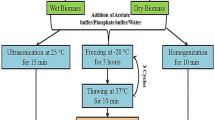Abstract
Low concentration of tea (Camellia sinensis (L.) O. Kuntze) was shown to inhibit the growth of the toxic cyanobacterium Microcystis aeruginosa. The inhibition efficiency was 40 % at 0.1 g dry tea/L and 90 % at 0.2 g/L after a 12-day culture. All varieties of tea used in the test could inhibit Microcystis growth, in which the inhibitory effect of green tea was greater than that of black tea. Antialgal allelochemicals were isolated from tea by solvent extraction, gel-chromatography and high performance liquid chromatography. Two algal-inhibition compounds were identified by liquid chromatography/mass spectrometry as epigallocatechin-3-gallate, epicatechin-3-gallate respectively. These are the main polyphenols in tea that have inhibitory effects on the growth of cyanobacteria. The combined effect of these polyphenols makes tea a promising source of algicide to inhibit the growth of algal blooms.




Similar content being viewed by others
References
Ball AS, Williams M, Vincent D, Robinson J (2001) Algal growth control by a barley straw extract. Bioresour Technol 77(2):177–181
Chen JZ, Liu ZL, Guanju R, Li PF, Jiang YW (2004) Control of Microcystis aeruginosa TH01109 with batangas mandarin skin and dwarf banana peel. Water SA 30:279–282
Choe S, Jung I (2001) Growth inhibition of freshwater algae by ester compounds released from rotted plant. Appl Chem 5(2):204–207
Codd GA, Morrison LF, Metcalf JS (2005) Cyanobacterial toxins: risk management for health protection. Toxicol Appl Pharmacol 203:264–272
Everall NC, Less DR (1997) The identification and significance of chemical released from decomposing barley straw during reservoir algal control. Water Res 31(3):614–620
Ferrier MD, Butler BR, Terlizzi DE, Lacouture RV (2005) The effects of barley straw (Hordeum vulgare) on the growth of freshwater algae. Bioresour Technol 96(16):1788–1795
Inderjit, Dakshini KMM, Einhellig FA (1995) Allelopathy: organisms, processes, and applications. ACS Symposium Series. American Chemical Society, Washington, DC
Nakai S, Inoue Y, Hosomi M (2001) Algal growth inhibition effects and inducement modes by plant-producing phenols. Water Res 35(7):1855–1859
Park MH, Han MS, Ahn CY, Kim HS, Yoon BD, Oh HM (2006) Growth inhibition of bloom-forming cyanobacterium Microcystis aeruginosa by rice straw extract. Lett Appl Microbiol 43(3):307–312
Rice EL, Lin CY, Huang CY (1980) Effects of decaying rice straw on growth and nitrogen fixation of a blue–green alga. Bot Bull Acad Sinica 21:111–117
Ridge I, Walters J, Street M (1999) Algal growth control by terrestrial leaf litter: a realistic tool? Hydrobiologia 395(396):173–180
Rippka R, Desrulles J, Waterbury JB, Herdman M, Stanier RY (1979) Generic assignment, strain histories and properties of pure cultures of cyanobacteria. J Gen Microbiol 11:1–61
Saito K, Matsumoto M, Sekine T, Murakoshi I, Morisaki N, Iwasaki S (1989) Inhibitory substances from Myriophyllum brasiliense on growth of blue–green algae. J Nat Prod 52(6):1221–1226
Tan X, Kong FX, Yu Y, Zhang M (2009) Spatio-temporal variations of phytoplankton community composition assayed by morphological observation and photosynthetic pigment analyses in Lake Taihu (China). Afr J Biotechnol 8(19):4977–4982
Zhao JW, Guo ZM, Chen QS, Lv Q (2008) Feasibility study on use of near-infrared spectroscopy in quantitative analysis of catechins in green tea. Acta Optica Sinica 28(12):2302–2306
Acknowledgments
This study was funded by the National Postdoctoral Science Foundation (2011M500958), Postdoctoral Science Foundation of Jiangsu Province (1101025B) and Youth Science and Technology Innovation Funds of Nanjing Agricultural University (Y0201100108).
Author information
Authors and Affiliations
Corresponding author
Rights and permissions
About this article
Cite this article
Lu, Y., Wang, J., Yu, Y. et al. Inhibition of Camellia sinensis (L.) O. Kuntze on Microcystis aeruginosa and isolation of the inhibition factors. Biotechnol Lett 35, 1029–1034 (2013). https://doi.org/10.1007/s10529-013-1188-4
Received:
Accepted:
Published:
Issue Date:
DOI: https://doi.org/10.1007/s10529-013-1188-4




